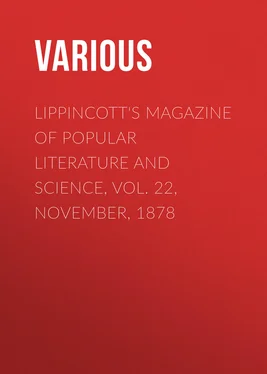Various - Lippincott's Magazine of Popular Literature and Science, Vol. 22, November, 1878
Здесь есть возможность читать онлайн «Various - Lippincott's Magazine of Popular Literature and Science, Vol. 22, November, 1878» — ознакомительный отрывок электронной книги совершенно бесплатно, а после прочтения отрывка купить полную версию. В некоторых случаях можно слушать аудио, скачать через торрент в формате fb2 и присутствует краткое содержание. Издательство: Иностранный паблик, Жанр: foreign_antique, periodic, foreign_edu, на английском языке. Описание произведения, (предисловие) а так же отзывы посетителей доступны на портале библиотеки ЛибКат.
- Название:Lippincott's Magazine of Popular Literature and Science, Vol. 22, November, 1878
- Автор:
- Издательство:Иностранный паблик
- Жанр:
- Год:неизвестен
- ISBN:нет данных
- Рейтинг книги:4 / 5. Голосов: 1
-
Избранное:Добавить в избранное
- Отзывы:
-
Ваша оценка:
- 80
- 1
- 2
- 3
- 4
- 5
Lippincott's Magazine of Popular Literature and Science, Vol. 22, November, 1878: краткое содержание, описание и аннотация
Предлагаем к чтению аннотацию, описание, краткое содержание или предисловие (зависит от того, что написал сам автор книги «Lippincott's Magazine of Popular Literature and Science, Vol. 22, November, 1878»). Если вы не нашли необходимую информацию о книге — напишите в комментариях, мы постараемся отыскать её.
Lippincott's Magazine of Popular Literature and Science, Vol. 22, November, 1878 — читать онлайн ознакомительный отрывок
Ниже представлен текст книги, разбитый по страницам. Система сохранения места последней прочитанной страницы, позволяет с удобством читать онлайн бесплатно книгу «Lippincott's Magazine of Popular Literature and Science, Vol. 22, November, 1878», без необходимости каждый раз заново искать на чём Вы остановились. Поставьте закладку, и сможете в любой момент перейти на страницу, на которой закончили чтение.
Интервал:
Закладка:
Various
Lippincott's Magazine of Popular Literature and Science, Vol. 22, November, 1878
SEAWANHAKA, THE ISLAND OF SHELLS
IT is not by any means certain what was the name by which Long Island was known to the aboriginal dwellers in its "forest primeval," or indeed that they ever had a common name by which to designate it. It seems probable that each tribe bestowed upon it a different name, expressive of the aspect that appeared most striking to its primitive and poetical visitors and occupants. Among so many tribes—the Canarsees (who met Hudson when on September 4, 1609, he anchored in Gravesend Bay), the Rockaways, Nyacks, Merrikokes, Matinecocs, Marsapeagues, Nissaquages, Corchaugs, Setaukets, Secataugs, Montauks, Shinecocs, Patchogues, and Manhansetts, to say nothing of the Pequots and Narragansetts on the northern shore of the Sound—a community of usage in regard to nomenclature could hardly be expected. We accordingly find that one of the old names of the island was Mattenwake, a compound of Mattai , the Delaware for "island." It was also called Paumanacke (the Indian original of the prosaic Long Island), Mattanwake (the Narragansett word for "good" or "pleasant land"), Pamunke and Meitowax. For a name, however, at once beautiful and suggestive, appropriate to an island whose sunny shores are strewn with shells, and recalling Indian feuds and customs, savage ornament and tributes paid in wampum, no name equals that we have chosen—Seawanhaka or Seawanhackee, the "Island of Shells."
No general description will give an adequate idea of its changing beauty and wellnigh infinite variety. Its scenery assumes a thousand different aspects between odoriferous Greenpoint and the solitary grandeur of Montauk. If one could only recall the old stagecoach, and, instead of whirling in a few hours from New York to Sag Harbor, creep slowly along the southern shore, and complete the journey of one hundred and ten miles in two days and a half, as they did fifty years ago, a description of the route would be both easy and interesting. Then the old stage lumbered out of Brooklyn about nine o'clock in the morning, a halt was made at Hempstead for dinner, and at Babylon the passengers slept. Starting early, they arrived in due time at Patchogue, where they breakfasted late, and thereby saved their dinner, and at Quogue, about twenty-four miles farther, they supped and slept. Again making an early start without breakfast, they jogged along to Southampton, where the morning meal was taken, and thus fortified they returned to their seats, and, passing through the beautiful country lying around Water Mill and Bridgehampton, rattled into Sag Harbor—a far different place from the Sag Harbor of to-day—and there dined. Fortunately, the rest of the route remains to us, and we can still "stage it" down the old and beautiful road to Easthampton. A leisurely journey of this description, at an average rate of a fraction less than two miles an hour, and with abundant opportunity of getting out for a brisk walk as the horses dragged their cumbrous load over an occasional sandhill, gave the traveller a chance of seeing the country he passed through. Long Island lay before him like a book, every line of which he could read at leisure. He could wander along the shore of the bay at Babylon, and mayhap meditate upon the beauty of Nature while looking at the moonlight sleeping on the water: he could at Quogue seek his way across the meadows and gaze upon the troubled face of the ocean. We can do so still, but these pleasures are no longer to be counted among the fascinating interludes of continuous travel. They are not the accompaniments of a long journey that gave it a flavor of romance, and made a trip to Sag Harbor and return the employment of an eventful and delightful week.
To adapt ourselves to modern conditions, and as we must view Long Island in sections to appreciate it as a whole, a route may be chosen in which, by using both railroad and stage, we may see even more of it, and that to greater advantage, than the old-time traveller. It is necessary, in the first place, that something should be seen of the northern shore. In character and associations it differs widely from the southern. There is, in the second place, the central section, in avoiding which much of the rural and most placid beauty of the island would be lost. There is, thirdly, the southern shore, varied in itself according as the point at which it is viewed lies on the ocean or on the landlocked bays between Hempstead and Mecoc, and extending to the rugged headland of Montauk. We shall thus, by passing from point to point, see as in a panorama all that need now attract our attention in viewing Seawanhaka.
The place which the Indians named Cumsewogue is now mainly distinguished by the cemetery of Cedar Hill. Passing among the graves, we reach the summit, and a wonderful scene bursts upon our view. Looking north toward where the village is nestling in a hollow surrounded by woods, the waters of Port Jefferson Bay are lying without a visible ripple; the sails of the ships passing up and down the Sound gleam in the sun; and beyond them, like a hazy line, are the shores of Connecticut. On the left are glimpses of farmhouses, the church-spires of Setauket, and rolling fields alternating with woods. On the right are more woods, bounded far away by the broken shore of the cliff-bound Sound. The wooded peninsula in front that stretches to the north, forming the eastern shore of Port Jefferson Bay, was named by the old Puritan settlers—for what reason it would be hard to divine—Mount Misery. It is now, fortunately, more generally known in the neighborhood by the name of the Strong estate of Oakwood. Sea, shore, woods and valleys make up a picturesque scene of peaceful beauty, and one forgets in the presence of its living charms that the site upon which he stands is within the limits of a city of the dead.
We descend into the village—which lies as if in a slumber that has lasted for a century and a half—at the head of the bay. The Indians named the place Souwassett, and the Puritans, in their usual matter-of-fact manner, called it Drowned Meadow. Its present name was adopted about forty years ago, probably in a patriotic mood, and also in the belief that the name it then bore was too unqualified and likely to give rise to unwarrantable prejudices. That there was some truth, if there was neither beauty nor imagination, in the name, is, however, evident from the marsh-lands lying between the village and Dyer's Neck or Poquott, which divides the harbor from that of Setauket on the west. One of the old landmarks of the village, dating from about the first quarter of the last century, is the house built by the Roe family when the settlement was first made. It now forms part of the Townsend house, and is still occupied by collateral descendants of its builder. Accessions to the little colony came slowly. Even the fine harbor could not compensate for the disadvantages of Drowned Meadow for building purposes, and the hillsides are steep and rocky. But about 1797, when it is said there were only half a dozen houses in the village, shipbuilding was begun, and its subsequent rise was comparatively rapid.
Securely though it seems to repose among its wood-crowned hills, it has had at least one exciting episode in its history. During the war of 1812 its shipping suffered considerably at the hands of King George's cruisers, and one night the enemy entered the harbor and captured seven sloops that were lying there at anchor. Otherwise, life at Port Jefferson appears to have been as it is now, unexciting and peaceful. Its attractions are in part those of association, but chiefly those of Nature—its sandy shore, its still woods and its placid bay. It is a place to fly to when the only conception of immediate happiness is to be still, to float idly upon water that has no waves to detract from the perfection of a dream of absolute rest, or to seek shelter and eloquent quiet in deep and shady woods. There are several winding paths that lead up the hilly promontory of Oakwood, and there are clearings upon the high ground swept over by breezes from the Sound where one can look upon rural scenes as perfect in their way as imagination can picture.
Читать дальшеИнтервал:
Закладка:
Похожие книги на «Lippincott's Magazine of Popular Literature and Science, Vol. 22, November, 1878»
Представляем Вашему вниманию похожие книги на «Lippincott's Magazine of Popular Literature and Science, Vol. 22, November, 1878» списком для выбора. Мы отобрали схожую по названию и смыслу литературу в надежде предоставить читателям больше вариантов отыскать новые, интересные, ещё непрочитанные произведения.
Обсуждение, отзывы о книге «Lippincott's Magazine of Popular Literature and Science, Vol. 22, November, 1878» и просто собственные мнения читателей. Оставьте ваши комментарии, напишите, что Вы думаете о произведении, его смысле или главных героях. Укажите что конкретно понравилось, а что нет, и почему Вы так считаете.












